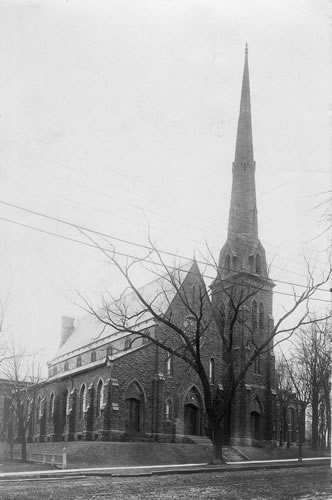Landmark Presbyterian Church stands as testament to 19th Century prosperity
Volume 2, Issue 34
ALBION – Few churches in Orleans County can boast such an extensive and prosperous history at the First Presbyterian Society. The earliest roots of the church date to 1816 when the First Congregational Society of Barre was formed at the home of Joseph Hart. Nearly twenty years later members from that church showed preference towards the Presbyterian style of church government and opted to relocate to the fledgling village that would later become Albion.
The founding members of that congregation included prominent residents such as Joseph Hart, Jedediah Phelps, and Harvey Goodrich who were subsequently selected as elders of the church; Hart was also selected as deacon. Following the organization of this new congregation, the church welcomed their first new member by baptism, the infant Flora Ann Hopkins, daughter of Milton Hopkins. Services were held in several locations including a schoolhouse on Main Street, a local barn, and for a period of time, the court house.
The desire to erect a permanent house of worship to call their own burned bright within the congregation. In 1830 the society met and decided to construct a church edifice at a total cost of no more than $4,000. The following year, the congregation celebrated the completion of their new brick church located on Main Street. That site remained active until the congregation elected to erect a new building on East State Street; the old church was sold to the Episcopalians.
The new Greek Revival church was completed in 1846 at a cost of $9,160 and included an organ and bell costing approximately $1,950. When the present church was constructed, this structure was converted into a chapel and the belfry later removed.
Following the death of Elizur Hart in 1870, a generous bequest of $50,000 (nearly $1,000,000 today) was left to erect the beautiful and impressive Gothic style edifice that stands today. The cost to construct such a striking building totaled nearly $80,000, so it was thanks in large part to Mr. Hart that this stunning landmark was completed. The building was dedicated in 1874 and finished with a Hook & Hastings two manual organ boasted as one of the finest in Western New York; the instrument was installed at an expense of $3,500.
The 175-foot steeple which remains a visible landmark on the horizon from miles around Albion weathered the storms of this area for over 60 years before the congregation determined the need for restoration work. Leading up to 1937, a series of storms had caused damage to the spire culminating in several stones falling to the ground that year. The windows that adorn the stone range from seven feet to four feet six inches in height and the capstone consists of three separate pieces of sandstone standing five feet ten inches tall.
Repairs to the steeple were completed in late 1937 after the congregation raised the necessary funds from nearly 450 churchgoers and community members. Upon commencement of the repairs, it was discovered that the top fifteen feet was leaning ten inches to the northeast.
This fine example of Gothic architecture constructed with Medina Sandstone stands as a testament to the ingenuity of the earliest settlers of Orleans County. It represents the foundation on which our area was built and reflects an age of great wealth, prosperity, and generosity. Few places in New York can claim such a rich cultural and architectural history as we have here.
Elizur Hart will be one of several prominent citizens featured during Sunday’s tour at Mt. Albion Cemetery. The Department of History is hosting tours of the cemetery on Sundays in August starting at 6 p.m. Tours will be led by Matthew Ballard and Bill Lattin and the group will depart from the cemetery chapel. Wear comfortable shoes and dress for the weather – this week’s tour includes a nice leisurely stroll and some very small hills!










































































